IKEA's Operation Management: Strategic Planning and Production
VerifiedAdded on 2021/06/30
|41
|12419
|334
Report
AI Summary
This report provides a detailed analysis of IKEA's operation management, covering its importance, strategic planning, and production processes. It explores how IKEA utilizes lean production principles, supply chain management, and quality management techniques to achieve its business objectives. The report also assesses the impact of cost minimization and quality maximization, the significance of performance objectives, and the application of linear programming and critical path analysis. Furthermore, it justifies the need for operational planning and control, and produces a set of operational outcomes for IKEA, including a network plan and the application of quality management techniques to improve operations. The analysis highlights IKEA's strategic system, core functions, and competitive advantages, emphasizing its commitment to low cost, quality, and customer satisfaction.
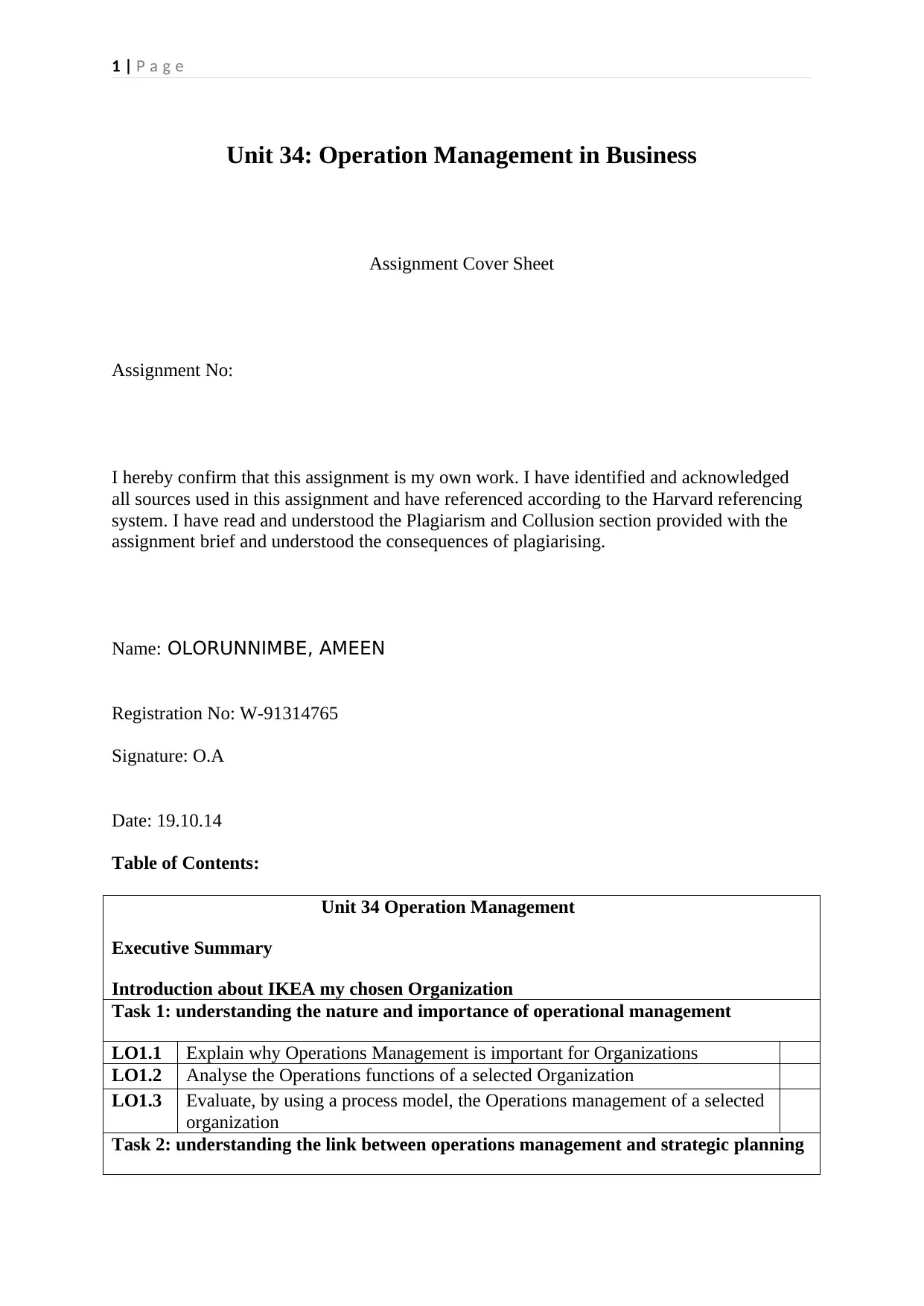
1 | P a g e
Unit 34: Operation Management in Business
Assignment Cover Sheet
Assignment No:
I hereby confirm that this assignment is my own work. I have identified and acknowledged
all sources used in this assignment and have referenced according to the Harvard referencing
system. I have read and understood the Plagiarism and Collusion section provided with the
assignment brief and understood the consequences of plagiarising.
Name: OLORUNNIMBE, AMEEN
Registration No: W-91314765
Signature: O.A
Date: 19.10.14
Table of Contents:
Unit 34 Operation Management
Executive Summary
Introduction about IKEA my chosen Organization
Task 1: understanding the nature and importance of operational management
LO1.1 Explain why Operations Management is important for Organizations
LO1.2 Analyse the Operations functions of a selected Organization
LO1.3 Evaluate, by using a process model, the Operations management of a selected
organization
Task 2: understanding the link between operations management and strategic planning
Unit 34: Operation Management in Business
Assignment Cover Sheet
Assignment No:
I hereby confirm that this assignment is my own work. I have identified and acknowledged
all sources used in this assignment and have referenced according to the Harvard referencing
system. I have read and understood the Plagiarism and Collusion section provided with the
assignment brief and understood the consequences of plagiarising.
Name: OLORUNNIMBE, AMEEN
Registration No: W-91314765
Signature: O.A
Date: 19.10.14
Table of Contents:
Unit 34 Operation Management
Executive Summary
Introduction about IKEA my chosen Organization
Task 1: understanding the nature and importance of operational management
LO1.1 Explain why Operations Management is important for Organizations
LO1.2 Analyse the Operations functions of a selected Organization
LO1.3 Evaluate, by using a process model, the Operations management of a selected
organization
Task 2: understanding the link between operations management and strategic planning
Paraphrase This Document
Need a fresh take? Get an instant paraphrase of this document with our AI Paraphraser
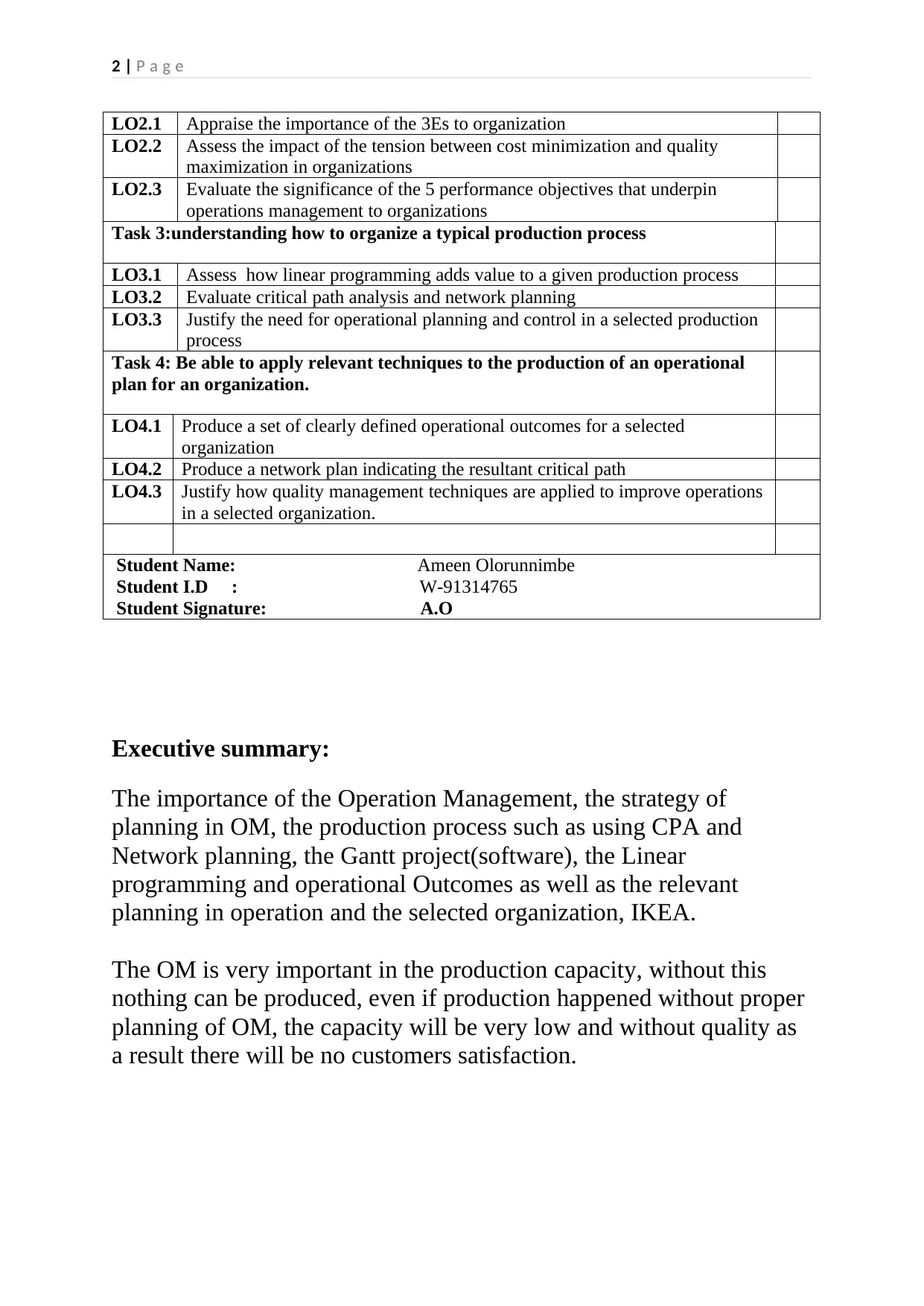
2 | P a g e
LO2.1 Appraise the importance of the 3Es to organization
LO2.2 Assess the impact of the tension between cost minimization and quality
maximization in organizations
LO2.3 Evaluate the significance of the 5 performance objectives that underpin
operations management to organizations
Task 3:understanding how to organize a typical production process
LO3.1 Assess how linear programming adds value to a given production process
LO3.2 Evaluate critical path analysis and network planning
LO3.3 Justify the need for operational planning and control in a selected production
process
Task 4: Be able to apply relevant techniques to the production of an operational
plan for an organization.
LO4.1 Produce a set of clearly defined operational outcomes for a selected
organization
LO4.2 Produce a network plan indicating the resultant critical path
LO4.3 Justify how quality management techniques are applied to improve operations
in a selected organization.
Student Name: Ameen Olorunnimbe
Student I.D : W-91314765
Student Signature: A.O
Executive summary:
The importance of the Operation Management, the strategy of
planning in OM, the production process such as using CPA and
Network planning, the Gantt project(software), the Linear
programming and operational Outcomes as well as the relevant
planning in operation and the selected organization, IKEA.
The OM is very important in the production capacity, without this
nothing can be produced, even if production happened without proper
planning of OM, the capacity will be very low and without quality as
a result there will be no customers satisfaction.
LO2.1 Appraise the importance of the 3Es to organization
LO2.2 Assess the impact of the tension between cost minimization and quality
maximization in organizations
LO2.3 Evaluate the significance of the 5 performance objectives that underpin
operations management to organizations
Task 3:understanding how to organize a typical production process
LO3.1 Assess how linear programming adds value to a given production process
LO3.2 Evaluate critical path analysis and network planning
LO3.3 Justify the need for operational planning and control in a selected production
process
Task 4: Be able to apply relevant techniques to the production of an operational
plan for an organization.
LO4.1 Produce a set of clearly defined operational outcomes for a selected
organization
LO4.2 Produce a network plan indicating the resultant critical path
LO4.3 Justify how quality management techniques are applied to improve operations
in a selected organization.
Student Name: Ameen Olorunnimbe
Student I.D : W-91314765
Student Signature: A.O
Executive summary:
The importance of the Operation Management, the strategy of
planning in OM, the production process such as using CPA and
Network planning, the Gantt project(software), the Linear
programming and operational Outcomes as well as the relevant
planning in operation and the selected organization, IKEA.
The OM is very important in the production capacity, without this
nothing can be produced, even if production happened without proper
planning of OM, the capacity will be very low and without quality as
a result there will be no customers satisfaction.
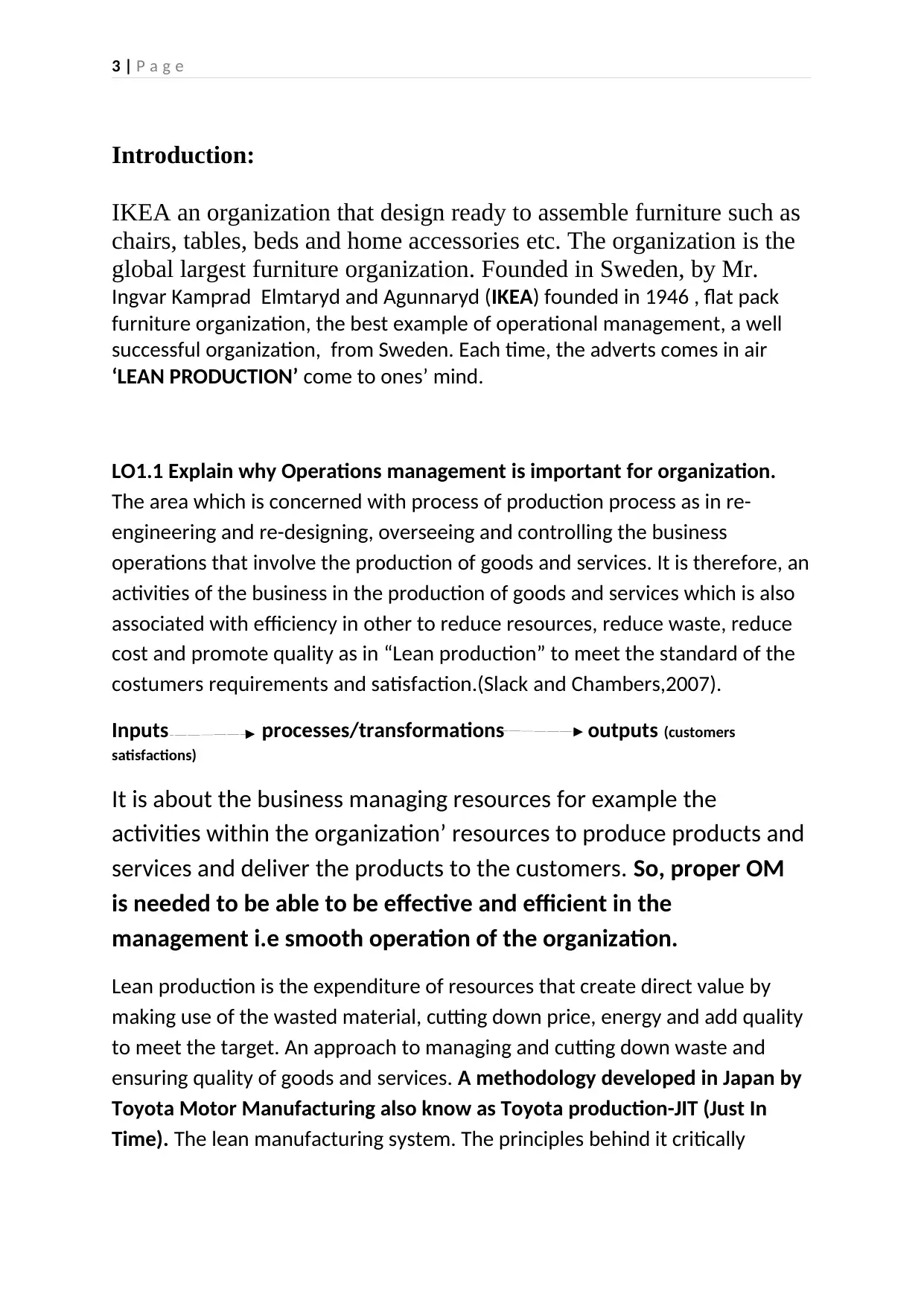
3 | P a g e
Introduction:
IKEA an organization that design ready to assemble furniture such as
chairs, tables, beds and home accessories etc. The organization is the
global largest furniture organization. Founded in Sweden, by Mr.
Ingvar Kamprad Elmtaryd and Agunnaryd (IKEA) founded in 1946 , flat pack
furniture organization, the best example of operational management, a well
successful organization, from Sweden. Each time, the adverts comes in air
‘LEAN PRODUCTION’ come to ones’ mind.
LO1.1 Explain why Operations management is important for organization.
The area which is concerned with process of production process as in re-
engineering and re-designing, overseeing and controlling the business
operations that involve the production of goods and services. It is therefore, an
activities of the business in the production of goods and services which is also
associated with efficiency in other to reduce resources, reduce waste, reduce
cost and promote quality as in “Lean production” to meet the standard of the
costumers requirements and satisfaction.(Slack and Chambers,2007).
Inputs processes/transformations outputs (customers
satisfactions)
It is about the business managing resources for example the
activities within the organization’ resources to produce products and
services and deliver the products to the customers. So, proper OM
is needed to be able to be effective and efficient in the
management i.e smooth operation of the organization.
Lean production is the expenditure of resources that create direct value by
making use of the wasted material, cutting down price, energy and add quality
to meet the target. An approach to managing and cutting down waste and
ensuring quality of goods and services. A methodology developed in Japan by
Toyota Motor Manufacturing also know as Toyota production-JIT (Just In
Time). The lean manufacturing system. The principles behind it critically
Introduction:
IKEA an organization that design ready to assemble furniture such as
chairs, tables, beds and home accessories etc. The organization is the
global largest furniture organization. Founded in Sweden, by Mr.
Ingvar Kamprad Elmtaryd and Agunnaryd (IKEA) founded in 1946 , flat pack
furniture organization, the best example of operational management, a well
successful organization, from Sweden. Each time, the adverts comes in air
‘LEAN PRODUCTION’ come to ones’ mind.
LO1.1 Explain why Operations management is important for organization.
The area which is concerned with process of production process as in re-
engineering and re-designing, overseeing and controlling the business
operations that involve the production of goods and services. It is therefore, an
activities of the business in the production of goods and services which is also
associated with efficiency in other to reduce resources, reduce waste, reduce
cost and promote quality as in “Lean production” to meet the standard of the
costumers requirements and satisfaction.(Slack and Chambers,2007).
Inputs processes/transformations outputs (customers
satisfactions)
It is about the business managing resources for example the
activities within the organization’ resources to produce products and
services and deliver the products to the customers. So, proper OM
is needed to be able to be effective and efficient in the
management i.e smooth operation of the organization.
Lean production is the expenditure of resources that create direct value by
making use of the wasted material, cutting down price, energy and add quality
to meet the target. An approach to managing and cutting down waste and
ensuring quality of goods and services. A methodology developed in Japan by
Toyota Motor Manufacturing also know as Toyota production-JIT (Just In
Time). The lean manufacturing system. The principles behind it critically
⊘ This is a preview!⊘
Do you want full access?
Subscribe today to unlock all pages.

Trusted by 1+ million students worldwide
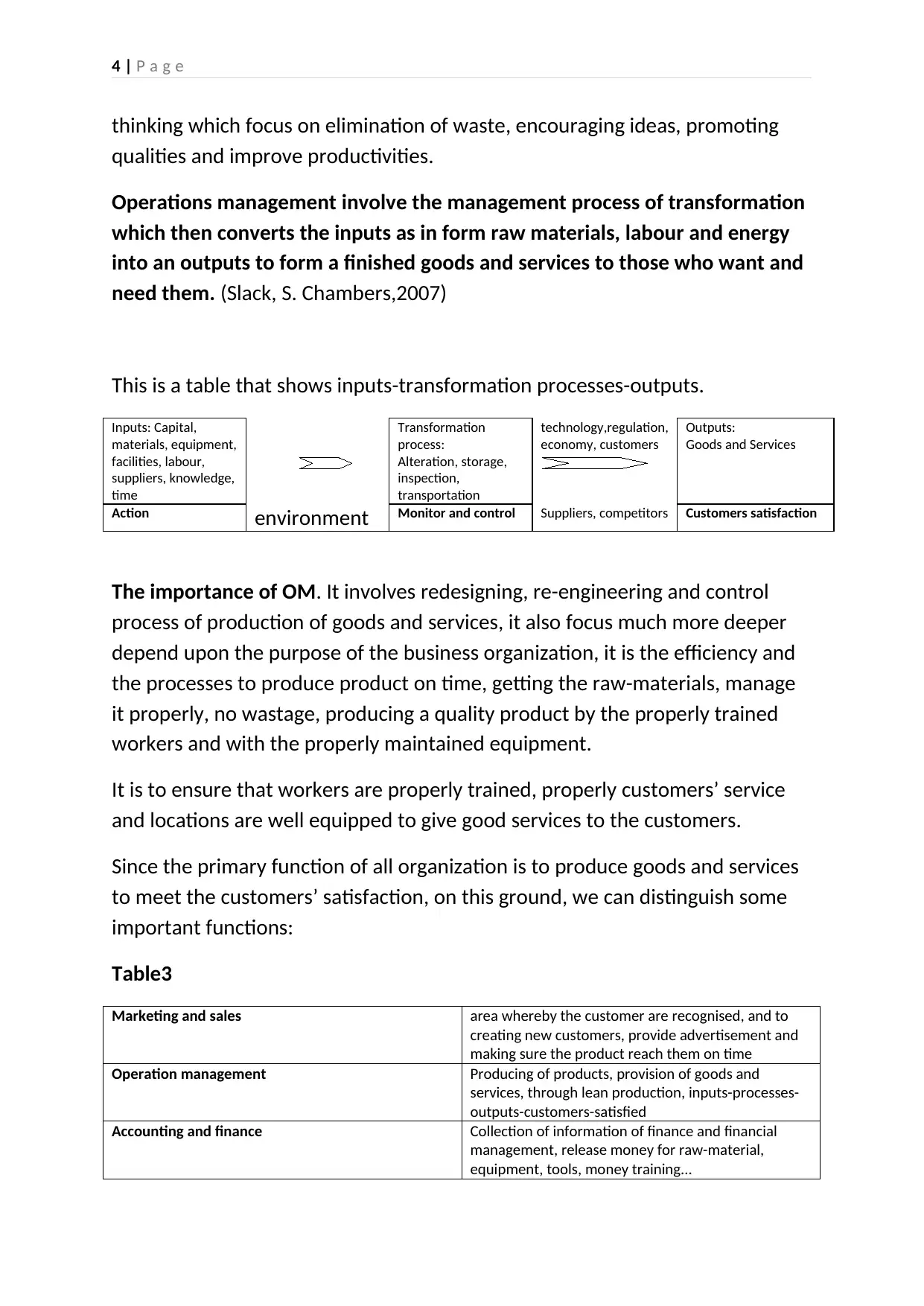
4 | P a g e
thinking which focus on elimination of waste, encouraging ideas, promoting
qualities and improve productivities.
Operations management involve the management process of transformation
which then converts the inputs as in form raw materials, labour and energy
into an outputs to form a finished goods and services to those who want and
need them. (Slack, S. Chambers,2007)
This is a table that shows inputs-transformation processes-outputs.
Inputs: Capital,
materials, equipment,
facilities, labour,
suppliers, knowledge,
time
Transformation
process:
Alteration, storage,
inspection,
transportation
technology,regulation,
economy, customers
Outputs:
Goods and Services
Action environment Monitor and control Suppliers, competitors Customers satisfaction
The importance of OM. It involves redesigning, re-engineering and control
process of production of goods and services, it also focus much more deeper
depend upon the purpose of the business organization, it is the efficiency and
the processes to produce product on time, getting the raw-materials, manage
it properly, no wastage, producing a quality product by the properly trained
workers and with the properly maintained equipment.
It is to ensure that workers are properly trained, properly customers’ service
and locations are well equipped to give good services to the customers.
Since the primary function of all organization is to produce goods and services
to meet the customers’ satisfaction, on this ground, we can distinguish some
important functions:
Table3
Marketing and sales area whereby the customer are recognised, and to
creating new customers, provide advertisement and
making sure the product reach them on time
Operation management Producing of products, provision of goods and
services, through lean production, inputs-processes-
outputs-customers-satisfied
Accounting and finance Collection of information of finance and financial
management, release money for raw-material,
equipment, tools, money training...
thinking which focus on elimination of waste, encouraging ideas, promoting
qualities and improve productivities.
Operations management involve the management process of transformation
which then converts the inputs as in form raw materials, labour and energy
into an outputs to form a finished goods and services to those who want and
need them. (Slack, S. Chambers,2007)
This is a table that shows inputs-transformation processes-outputs.
Inputs: Capital,
materials, equipment,
facilities, labour,
suppliers, knowledge,
time
Transformation
process:
Alteration, storage,
inspection,
transportation
technology,regulation,
economy, customers
Outputs:
Goods and Services
Action environment Monitor and control Suppliers, competitors Customers satisfaction
The importance of OM. It involves redesigning, re-engineering and control
process of production of goods and services, it also focus much more deeper
depend upon the purpose of the business organization, it is the efficiency and
the processes to produce product on time, getting the raw-materials, manage
it properly, no wastage, producing a quality product by the properly trained
workers and with the properly maintained equipment.
It is to ensure that workers are properly trained, properly customers’ service
and locations are well equipped to give good services to the customers.
Since the primary function of all organization is to produce goods and services
to meet the customers’ satisfaction, on this ground, we can distinguish some
important functions:
Table3
Marketing and sales area whereby the customer are recognised, and to
creating new customers, provide advertisement and
making sure the product reach them on time
Operation management Producing of products, provision of goods and
services, through lean production, inputs-processes-
outputs-customers-satisfied
Accounting and finance Collection of information of finance and financial
management, release money for raw-material,
equipment, tools, money training...
Paraphrase This Document
Need a fresh take? Get an instant paraphrase of this document with our AI Paraphraser
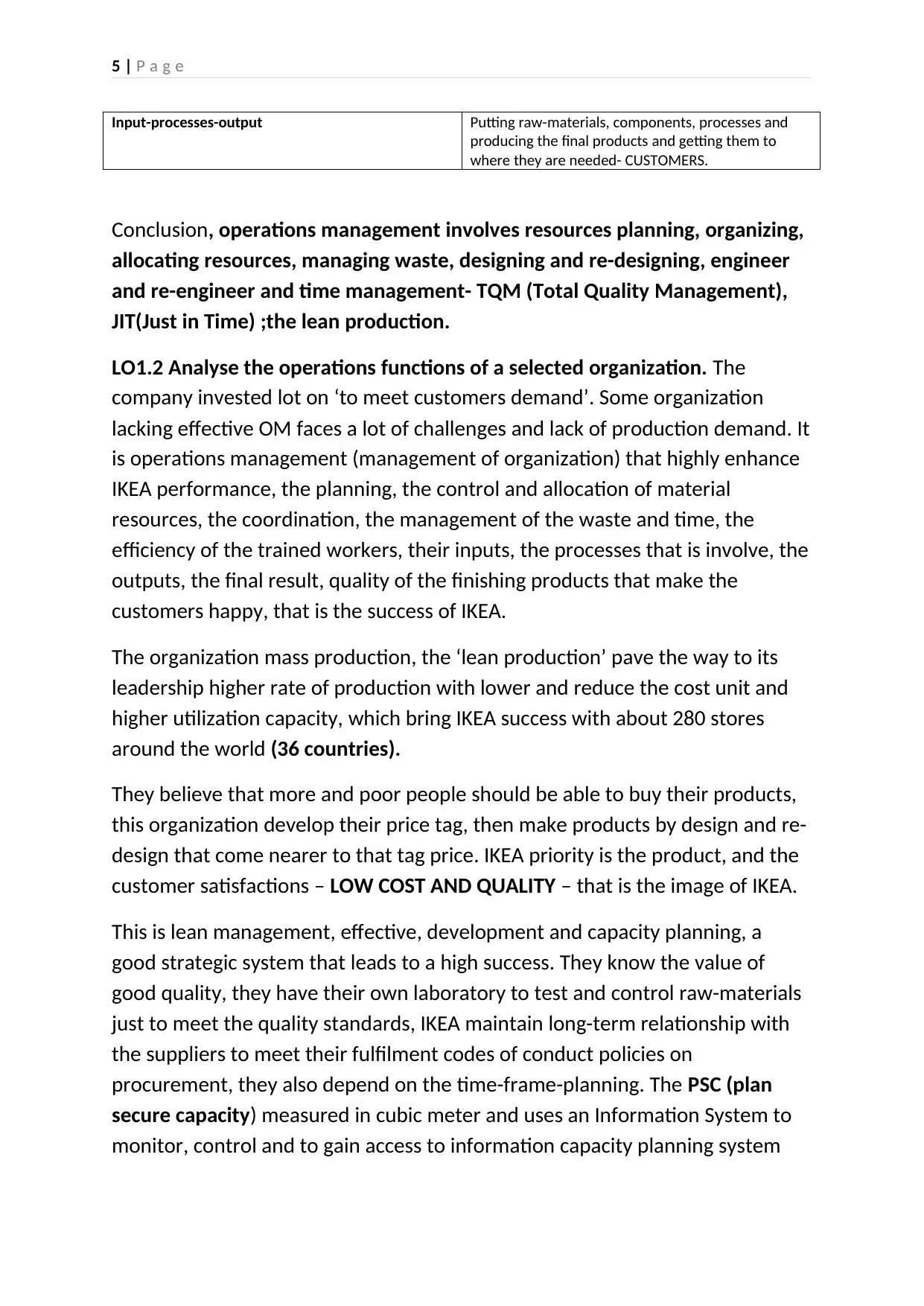
5 | P a g e
Input-processes-output Putting raw-materials, components, processes and
producing the final products and getting them to
where they are needed- CUSTOMERS.
Conclusion, operations management involves resources planning, organizing,
allocating resources, managing waste, designing and re-designing, engineer
and re-engineer and time management- TQM (Total Quality Management),
JIT(Just in Time) ;the lean production.
LO1.2 Analyse the operations functions of a selected organization. The
company invested lot on ‘to meet customers demand’. Some organization
lacking effective OM faces a lot of challenges and lack of production demand. It
is operations management (management of organization) that highly enhance
IKEA performance, the planning, the control and allocation of material
resources, the coordination, the management of the waste and time, the
efficiency of the trained workers, their inputs, the processes that is involve, the
outputs, the final result, quality of the finishing products that make the
customers happy, that is the success of IKEA.
The organization mass production, the ‘lean production’ pave the way to its
leadership higher rate of production with lower and reduce the cost unit and
higher utilization capacity, which bring IKEA success with about 280 stores
around the world (36 countries).
They believe that more and poor people should be able to buy their products,
this organization develop their price tag, then make products by design and re-
design that come nearer to that tag price. IKEA priority is the product, and the
customer satisfactions – LOW COST AND QUALITY – that is the image of IKEA.
This is lean management, effective, development and capacity planning, a
good strategic system that leads to a high success. They know the value of
good quality, they have their own laboratory to test and control raw-materials
just to meet the quality standards, IKEA maintain long-term relationship with
the suppliers to meet their fulfilment codes of conduct policies on
procurement, they also depend on the time-frame-planning. The PSC (plan
secure capacity) measured in cubic meter and uses an Information System to
monitor, control and to gain access to information capacity planning system
Input-processes-output Putting raw-materials, components, processes and
producing the final products and getting them to
where they are needed- CUSTOMERS.
Conclusion, operations management involves resources planning, organizing,
allocating resources, managing waste, designing and re-designing, engineer
and re-engineer and time management- TQM (Total Quality Management),
JIT(Just in Time) ;the lean production.
LO1.2 Analyse the operations functions of a selected organization. The
company invested lot on ‘to meet customers demand’. Some organization
lacking effective OM faces a lot of challenges and lack of production demand. It
is operations management (management of organization) that highly enhance
IKEA performance, the planning, the control and allocation of material
resources, the coordination, the management of the waste and time, the
efficiency of the trained workers, their inputs, the processes that is involve, the
outputs, the final result, quality of the finishing products that make the
customers happy, that is the success of IKEA.
The organization mass production, the ‘lean production’ pave the way to its
leadership higher rate of production with lower and reduce the cost unit and
higher utilization capacity, which bring IKEA success with about 280 stores
around the world (36 countries).
They believe that more and poor people should be able to buy their products,
this organization develop their price tag, then make products by design and re-
design that come nearer to that tag price. IKEA priority is the product, and the
customer satisfactions – LOW COST AND QUALITY – that is the image of IKEA.
This is lean management, effective, development and capacity planning, a
good strategic system that leads to a high success. They know the value of
good quality, they have their own laboratory to test and control raw-materials
just to meet the quality standards, IKEA maintain long-term relationship with
the suppliers to meet their fulfilment codes of conduct policies on
procurement, they also depend on the time-frame-planning. The PSC (plan
secure capacity) measured in cubic meter and uses an Information System to
monitor, control and to gain access to information capacity planning system
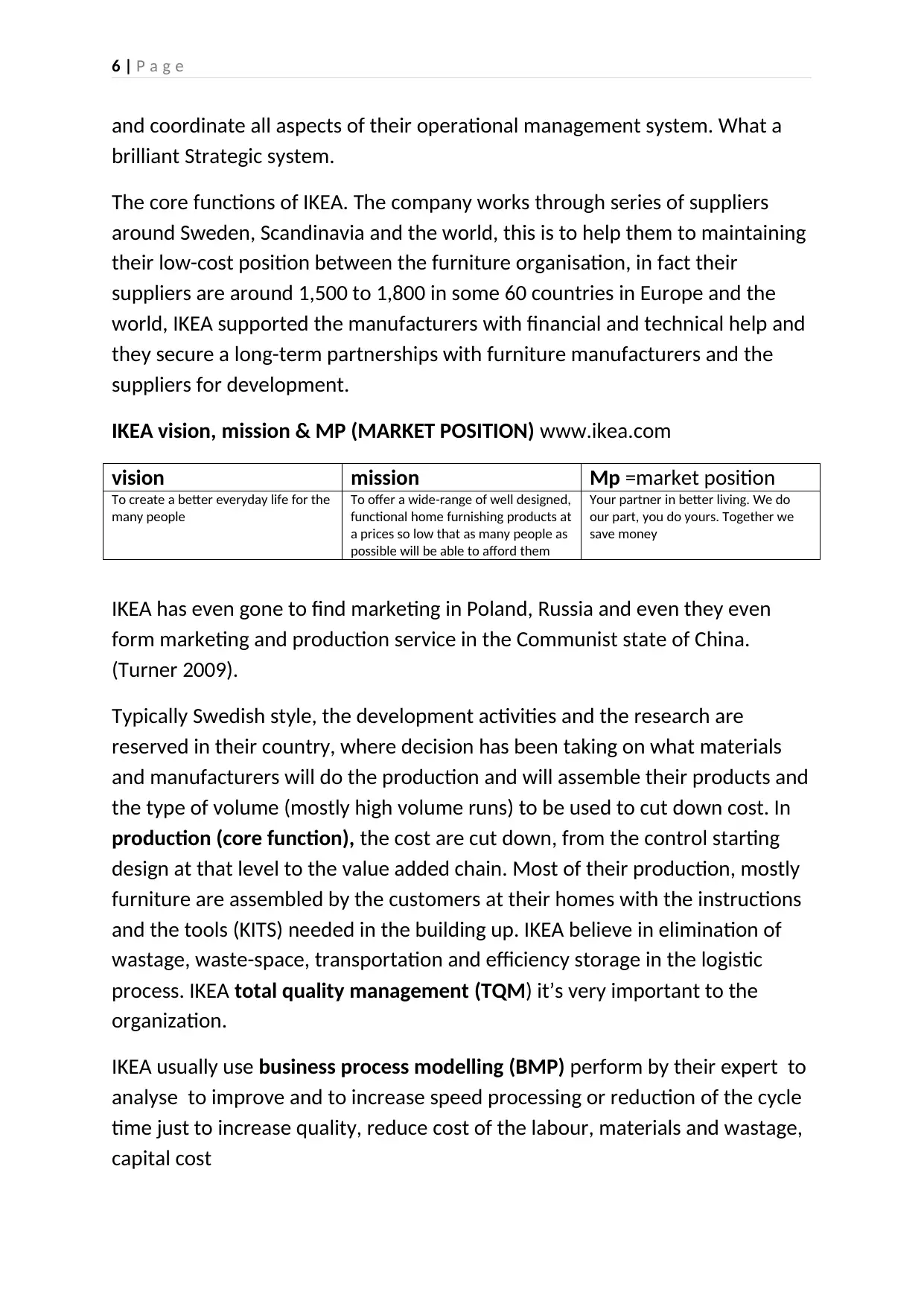
6 | P a g e
and coordinate all aspects of their operational management system. What a
brilliant Strategic system.
The core functions of IKEA. The company works through series of suppliers
around Sweden, Scandinavia and the world, this is to help them to maintaining
their low-cost position between the furniture organisation, in fact their
suppliers are around 1,500 to 1,800 in some 60 countries in Europe and the
world, IKEA supported the manufacturers with financial and technical help and
they secure a long-term partnerships with furniture manufacturers and the
suppliers for development.
IKEA vision, mission & MP (MARKET POSITION) www.ikea.com
vision mission Mp =market position
To create a better everyday life for the
many people
To offer a wide-range of well designed,
functional home furnishing products at
a prices so low that as many people as
possible will be able to afford them
Your partner in better living. We do
our part, you do yours. Together we
save money
IKEA has even gone to find marketing in Poland, Russia and even they even
form marketing and production service in the Communist state of China.
(Turner 2009).
Typically Swedish style, the development activities and the research are
reserved in their country, where decision has been taking on what materials
and manufacturers will do the production and will assemble their products and
the type of volume (mostly high volume runs) to be used to cut down cost. In
production (core function), the cost are cut down, from the control starting
design at that level to the value added chain. Most of their production, mostly
furniture are assembled by the customers at their homes with the instructions
and the tools (KITS) needed in the building up. IKEA believe in elimination of
wastage, waste-space, transportation and efficiency storage in the logistic
process. IKEA total quality management (TQM) it’s very important to the
organization.
IKEA usually use business process modelling (BMP) perform by their expert to
analyse to improve and to increase speed processing or reduction of the cycle
time just to increase quality, reduce cost of the labour, materials and wastage,
capital cost
and coordinate all aspects of their operational management system. What a
brilliant Strategic system.
The core functions of IKEA. The company works through series of suppliers
around Sweden, Scandinavia and the world, this is to help them to maintaining
their low-cost position between the furniture organisation, in fact their
suppliers are around 1,500 to 1,800 in some 60 countries in Europe and the
world, IKEA supported the manufacturers with financial and technical help and
they secure a long-term partnerships with furniture manufacturers and the
suppliers for development.
IKEA vision, mission & MP (MARKET POSITION) www.ikea.com
vision mission Mp =market position
To create a better everyday life for the
many people
To offer a wide-range of well designed,
functional home furnishing products at
a prices so low that as many people as
possible will be able to afford them
Your partner in better living. We do
our part, you do yours. Together we
save money
IKEA has even gone to find marketing in Poland, Russia and even they even
form marketing and production service in the Communist state of China.
(Turner 2009).
Typically Swedish style, the development activities and the research are
reserved in their country, where decision has been taking on what materials
and manufacturers will do the production and will assemble their products and
the type of volume (mostly high volume runs) to be used to cut down cost. In
production (core function), the cost are cut down, from the control starting
design at that level to the value added chain. Most of their production, mostly
furniture are assembled by the customers at their homes with the instructions
and the tools (KITS) needed in the building up. IKEA believe in elimination of
wastage, waste-space, transportation and efficiency storage in the logistic
process. IKEA total quality management (TQM) it’s very important to the
organization.
IKEA usually use business process modelling (BMP) perform by their expert to
analyse to improve and to increase speed processing or reduction of the cycle
time just to increase quality, reduce cost of the labour, materials and wastage,
capital cost
⊘ This is a preview!⊘
Do you want full access?
Subscribe today to unlock all pages.

Trusted by 1+ million students worldwide
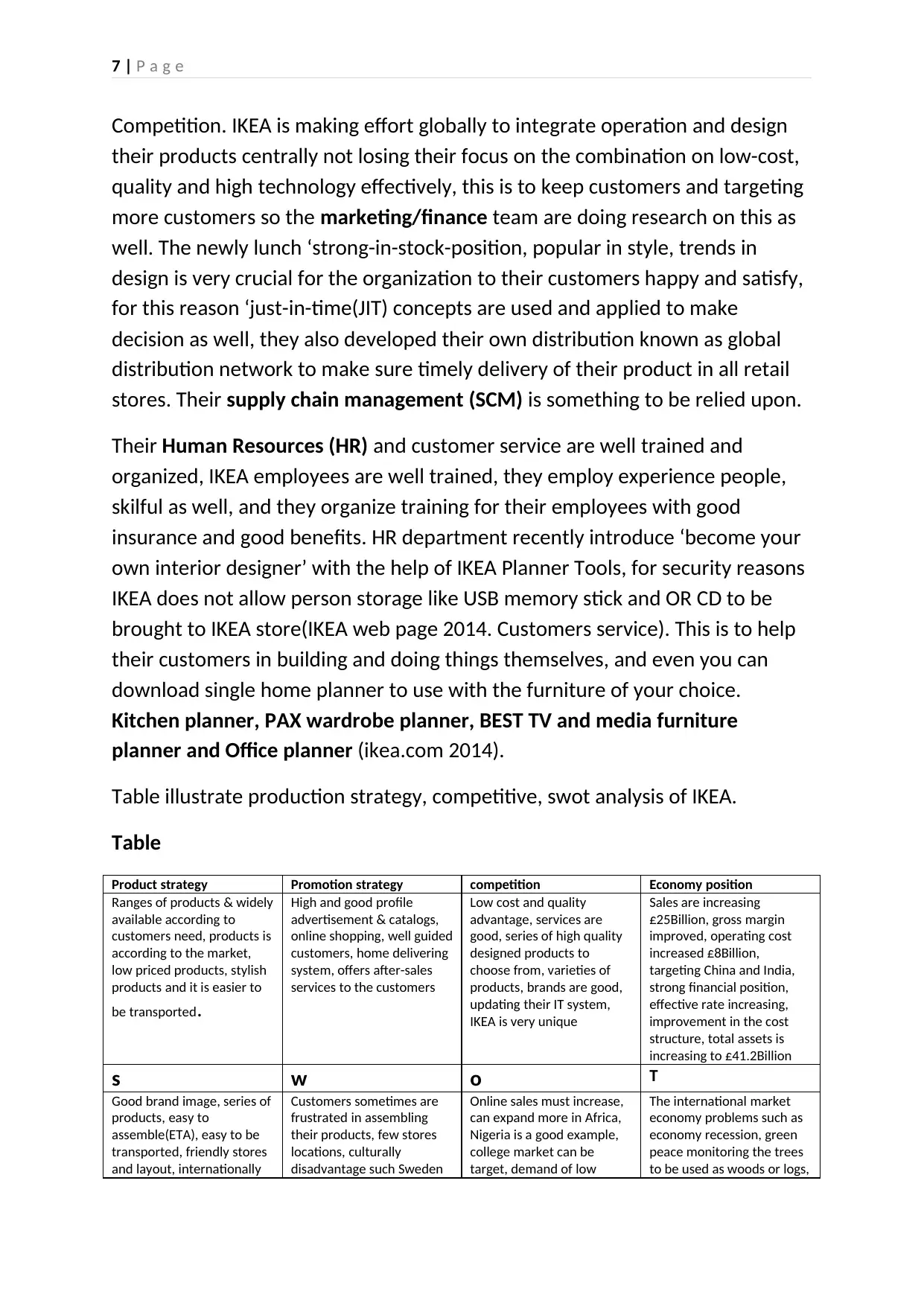
7 | P a g e
Competition. IKEA is making effort globally to integrate operation and design
their products centrally not losing their focus on the combination on low-cost,
quality and high technology effectively, this is to keep customers and targeting
more customers so the marketing/finance team are doing research on this as
well. The newly lunch ‘strong-in-stock-position, popular in style, trends in
design is very crucial for the organization to their customers happy and satisfy,
for this reason ‘just-in-time(JIT) concepts are used and applied to make
decision as well, they also developed their own distribution known as global
distribution network to make sure timely delivery of their product in all retail
stores. Their supply chain management (SCM) is something to be relied upon.
Their Human Resources (HR) and customer service are well trained and
organized, IKEA employees are well trained, they employ experience people,
skilful as well, and they organize training for their employees with good
insurance and good benefits. HR department recently introduce ‘become your
own interior designer’ with the help of IKEA Planner Tools, for security reasons
IKEA does not allow person storage like USB memory stick and OR CD to be
brought to IKEA store(IKEA web page 2014. Customers service). This is to help
their customers in building and doing things themselves, and even you can
download single home planner to use with the furniture of your choice.
Kitchen planner, PAX wardrobe planner, BEST TV and media furniture
planner and Office planner (ikea.com 2014).
Table illustrate production strategy, competitive, swot analysis of IKEA.
Table
Product strategy Promotion strategy competition Economy position
Ranges of products & widely
available according to
customers need, products is
according to the market,
low priced products, stylish
products and it is easier to
be transported.
High and good profile
advertisement & catalogs,
online shopping, well guided
customers, home delivering
system, offers after-sales
services to the customers
Low cost and quality
advantage, services are
good, series of high quality
designed products to
choose from, varieties of
products, brands are good,
updating their IT system,
IKEA is very unique
Sales are increasing
£25Billion, gross margin
improved, operating cost
increased £8Billion,
targeting China and India,
strong financial position,
effective rate increasing,
improvement in the cost
structure, total assets is
increasing to £41.2Billion
s w o T
Good brand image, series of
products, easy to
assemble(ETA), easy to be
transported, friendly stores
and layout, internationally
Customers sometimes are
frustrated in assembling
their products, few stores
locations, culturally
disadvantage such Sweden
Online sales must increase,
can expand more in Africa,
Nigeria is a good example,
college market can be
target, demand of low
The international market
economy problems such as
economy recession, green
peace monitoring the trees
to be used as woods or logs,
Competition. IKEA is making effort globally to integrate operation and design
their products centrally not losing their focus on the combination on low-cost,
quality and high technology effectively, this is to keep customers and targeting
more customers so the marketing/finance team are doing research on this as
well. The newly lunch ‘strong-in-stock-position, popular in style, trends in
design is very crucial for the organization to their customers happy and satisfy,
for this reason ‘just-in-time(JIT) concepts are used and applied to make
decision as well, they also developed their own distribution known as global
distribution network to make sure timely delivery of their product in all retail
stores. Their supply chain management (SCM) is something to be relied upon.
Their Human Resources (HR) and customer service are well trained and
organized, IKEA employees are well trained, they employ experience people,
skilful as well, and they organize training for their employees with good
insurance and good benefits. HR department recently introduce ‘become your
own interior designer’ with the help of IKEA Planner Tools, for security reasons
IKEA does not allow person storage like USB memory stick and OR CD to be
brought to IKEA store(IKEA web page 2014. Customers service). This is to help
their customers in building and doing things themselves, and even you can
download single home planner to use with the furniture of your choice.
Kitchen planner, PAX wardrobe planner, BEST TV and media furniture
planner and Office planner (ikea.com 2014).
Table illustrate production strategy, competitive, swot analysis of IKEA.
Table
Product strategy Promotion strategy competition Economy position
Ranges of products & widely
available according to
customers need, products is
according to the market,
low priced products, stylish
products and it is easier to
be transported.
High and good profile
advertisement & catalogs,
online shopping, well guided
customers, home delivering
system, offers after-sales
services to the customers
Low cost and quality
advantage, services are
good, series of high quality
designed products to
choose from, varieties of
products, brands are good,
updating their IT system,
IKEA is very unique
Sales are increasing
£25Billion, gross margin
improved, operating cost
increased £8Billion,
targeting China and India,
strong financial position,
effective rate increasing,
improvement in the cost
structure, total assets is
increasing to £41.2Billion
s w o T
Good brand image, series of
products, easy to
assemble(ETA), easy to be
transported, friendly stores
and layout, internationally
Customers sometimes are
frustrated in assembling
their products, few stores
locations, culturally
disadvantage such Sweden
Online sales must increase,
can expand more in Africa,
Nigeria is a good example,
college market can be
target, demand of low
The international market
economy problems such as
economy recession, green
peace monitoring the trees
to be used as woods or logs,
Paraphrase This Document
Need a fresh take? Get an instant paraphrase of this document with our AI Paraphraser
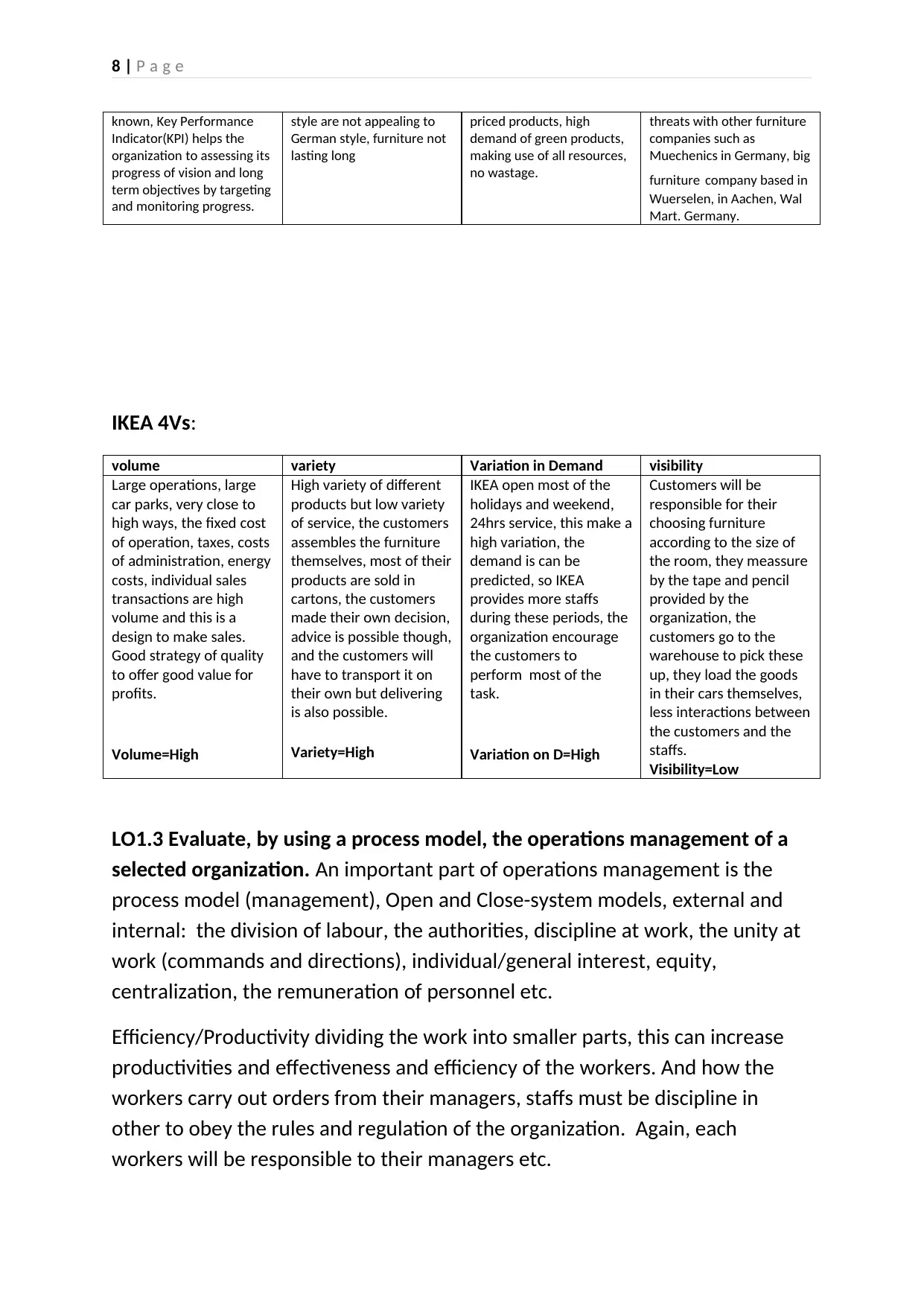
8 | P a g e
known, Key Performance
Indicator(KPI) helps the
organization to assessing its
progress of vision and long
term objectives by targeting
and monitoring progress.
style are not appealing to
German style, furniture not
lasting long
priced products, high
demand of green products,
making use of all resources,
no wastage.
threats with other furniture
companies such as
Muechenics in Germany, big
furniture company based in
Wuerselen, in Aachen, Wal
Mart. Germany.
IKEA 4Vs:
volume variety Variation in Demand visibility
Large operations, large
car parks, very close to
high ways, the fixed cost
of operation, taxes, costs
of administration, energy
costs, individual sales
transactions are high
volume and this is a
design to make sales.
Good strategy of quality
to offer good value for
profits.
Volume=High
High variety of different
products but low variety
of service, the customers
assembles the furniture
themselves, most of their
products are sold in
cartons, the customers
made their own decision,
advice is possible though,
and the customers will
have to transport it on
their own but delivering
is also possible.
Variety=High
IKEA open most of the
holidays and weekend,
24hrs service, this make a
high variation, the
demand is can be
predicted, so IKEA
provides more staffs
during these periods, the
organization encourage
the customers to
perform most of the
task.
Variation on D=High
Customers will be
responsible for their
choosing furniture
according to the size of
the room, they meassure
by the tape and pencil
provided by the
organization, the
customers go to the
warehouse to pick these
up, they load the goods
in their cars themselves,
less interactions between
the customers and the
staffs.
Visibility=Low
LO1.3 Evaluate, by using a process model, the operations management of a
selected organization. An important part of operations management is the
process model (management), Open and Close-system models, external and
internal: the division of labour, the authorities, discipline at work, the unity at
work (commands and directions), individual/general interest, equity,
centralization, the remuneration of personnel etc.
Efficiency/Productivity dividing the work into smaller parts, this can increase
productivities and effectiveness and efficiency of the workers. And how the
workers carry out orders from their managers, staffs must be discipline in
other to obey the rules and regulation of the organization. Again, each
workers will be responsible to their managers etc.
known, Key Performance
Indicator(KPI) helps the
organization to assessing its
progress of vision and long
term objectives by targeting
and monitoring progress.
style are not appealing to
German style, furniture not
lasting long
priced products, high
demand of green products,
making use of all resources,
no wastage.
threats with other furniture
companies such as
Muechenics in Germany, big
furniture company based in
Wuerselen, in Aachen, Wal
Mart. Germany.
IKEA 4Vs:
volume variety Variation in Demand visibility
Large operations, large
car parks, very close to
high ways, the fixed cost
of operation, taxes, costs
of administration, energy
costs, individual sales
transactions are high
volume and this is a
design to make sales.
Good strategy of quality
to offer good value for
profits.
Volume=High
High variety of different
products but low variety
of service, the customers
assembles the furniture
themselves, most of their
products are sold in
cartons, the customers
made their own decision,
advice is possible though,
and the customers will
have to transport it on
their own but delivering
is also possible.
Variety=High
IKEA open most of the
holidays and weekend,
24hrs service, this make a
high variation, the
demand is can be
predicted, so IKEA
provides more staffs
during these periods, the
organization encourage
the customers to
perform most of the
task.
Variation on D=High
Customers will be
responsible for their
choosing furniture
according to the size of
the room, they meassure
by the tape and pencil
provided by the
organization, the
customers go to the
warehouse to pick these
up, they load the goods
in their cars themselves,
less interactions between
the customers and the
staffs.
Visibility=Low
LO1.3 Evaluate, by using a process model, the operations management of a
selected organization. An important part of operations management is the
process model (management), Open and Close-system models, external and
internal: the division of labour, the authorities, discipline at work, the unity at
work (commands and directions), individual/general interest, equity,
centralization, the remuneration of personnel etc.
Efficiency/Productivity dividing the work into smaller parts, this can increase
productivities and effectiveness and efficiency of the workers. And how the
workers carry out orders from their managers, staffs must be discipline in
other to obey the rules and regulation of the organization. Again, each
workers will be responsible to their managers etc.
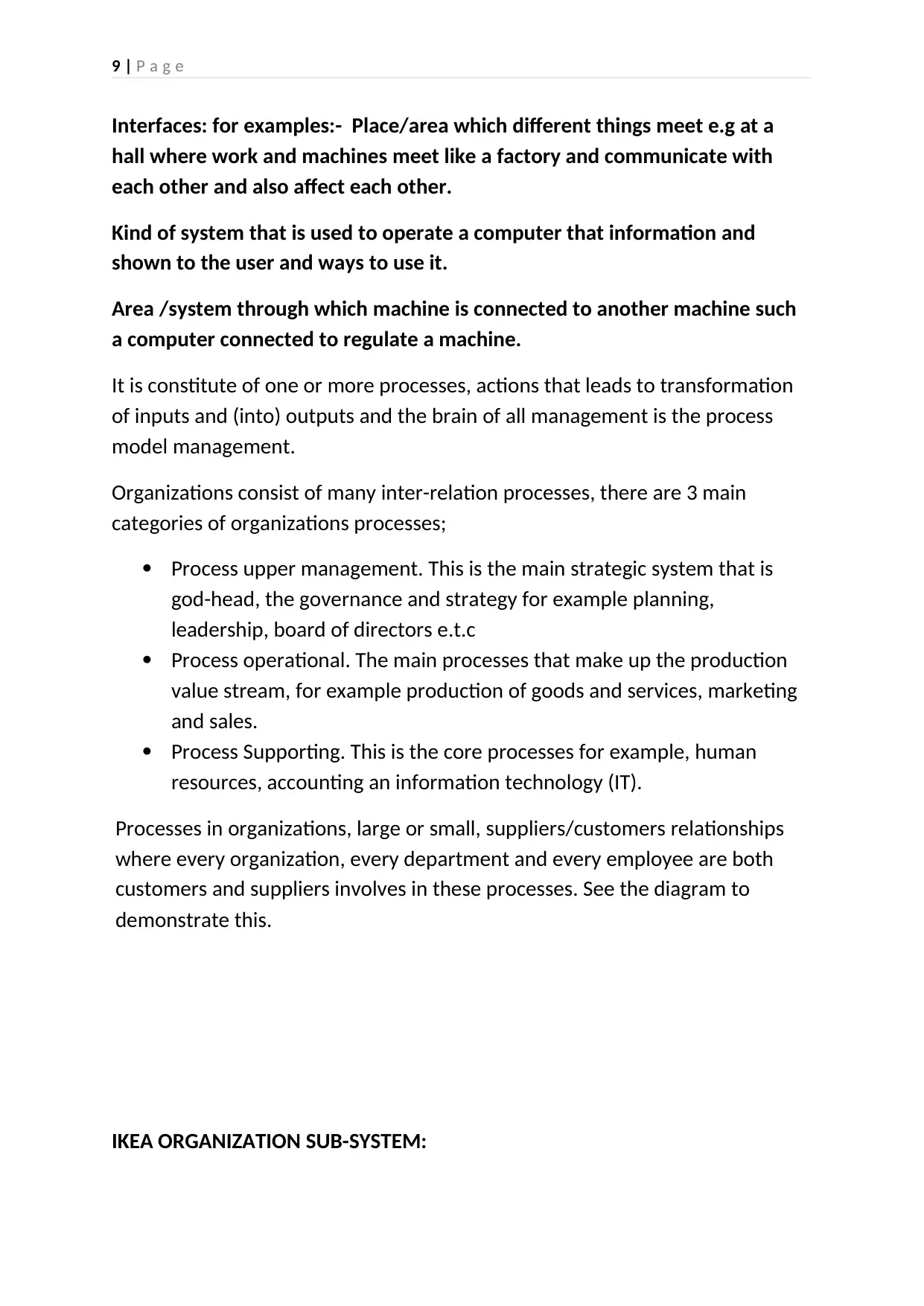
9 | P a g e
Interfaces: for examples:- Place/area which different things meet e.g at a
hall where work and machines meet like a factory and communicate with
each other and also affect each other.
Kind of system that is used to operate a computer that information and
shown to the user and ways to use it.
Area /system through which machine is connected to another machine such
a computer connected to regulate a machine.
It is constitute of one or more processes, actions that leads to transformation
of inputs and (into) outputs and the brain of all management is the process
model management.
Organizations consist of many inter-relation processes, there are 3 main
categories of organizations processes;
Process upper management. This is the main strategic system that is
god-head, the governance and strategy for example planning,
leadership, board of directors e.t.c
Process operational. The main processes that make up the production
value stream, for example production of goods and services, marketing
and sales.
Process Supporting. This is the core processes for example, human
resources, accounting an information technology (IT).
Processes in organizations, large or small, suppliers/customers relationships
where every organization, every department and every employee are both
customers and suppliers involves in these processes. See the diagram to
demonstrate this.
IKEA ORGANIZATION SUB-SYSTEM:
Interfaces: for examples:- Place/area which different things meet e.g at a
hall where work and machines meet like a factory and communicate with
each other and also affect each other.
Kind of system that is used to operate a computer that information and
shown to the user and ways to use it.
Area /system through which machine is connected to another machine such
a computer connected to regulate a machine.
It is constitute of one or more processes, actions that leads to transformation
of inputs and (into) outputs and the brain of all management is the process
model management.
Organizations consist of many inter-relation processes, there are 3 main
categories of organizations processes;
Process upper management. This is the main strategic system that is
god-head, the governance and strategy for example planning,
leadership, board of directors e.t.c
Process operational. The main processes that make up the production
value stream, for example production of goods and services, marketing
and sales.
Process Supporting. This is the core processes for example, human
resources, accounting an information technology (IT).
Processes in organizations, large or small, suppliers/customers relationships
where every organization, every department and every employee are both
customers and suppliers involves in these processes. See the diagram to
demonstrate this.
IKEA ORGANIZATION SUB-SYSTEM:
⊘ This is a preview!⊘
Do you want full access?
Subscribe today to unlock all pages.

Trusted by 1+ million students worldwide
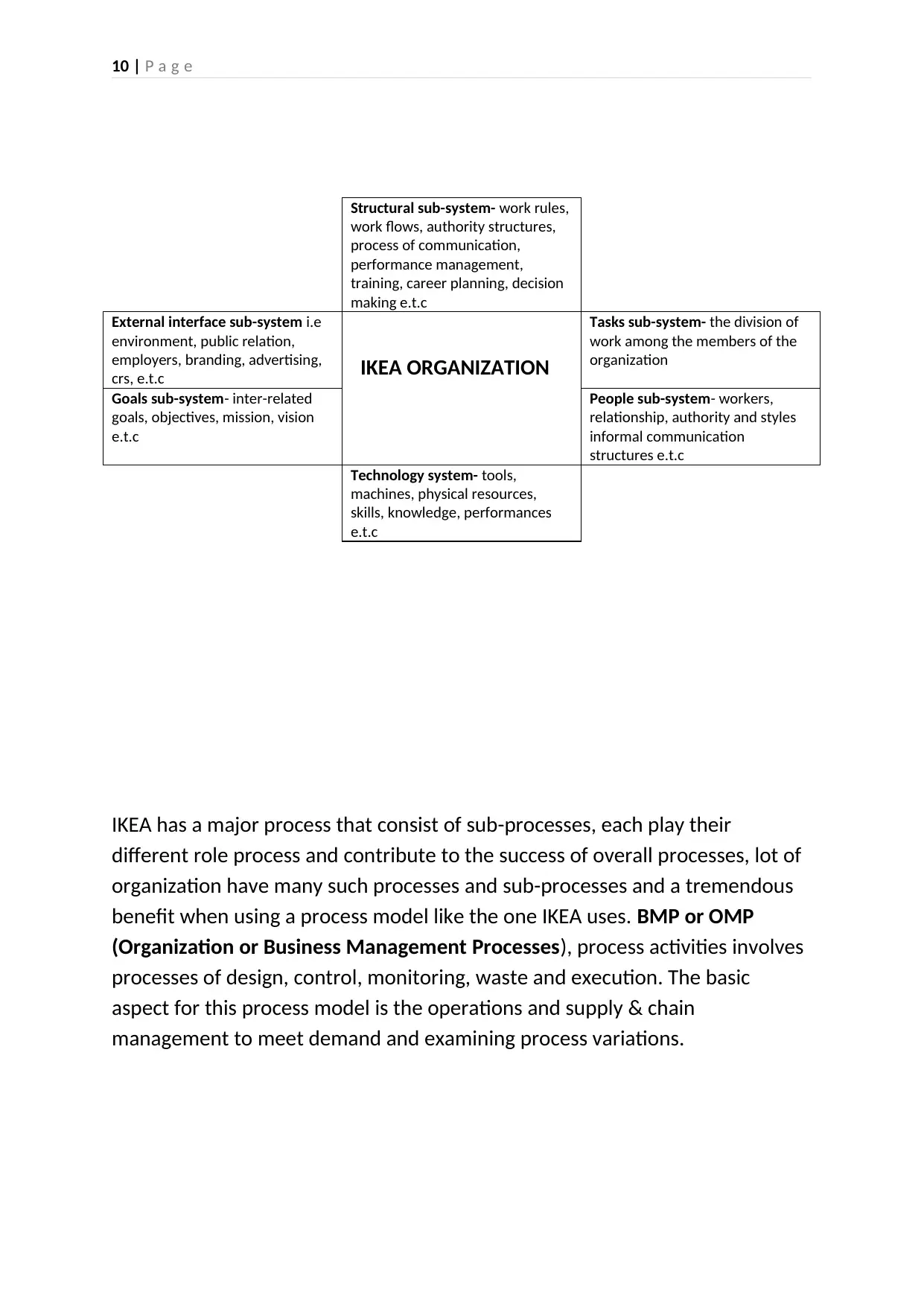
10 | P a g e
Structural sub-system- work rules,
work flows, authority structures,
process of communication,
performance management,
training, career planning, decision
making e.t.c
External interface sub-system i.e
environment, public relation,
employers, branding, advertising,
crs, e.t.c IKEA ORGANIZATION
Tasks sub-system- the division of
work among the members of the
organization
Goals sub-system- inter-related
goals, objectives, mission, vision
e.t.c
People sub-system- workers,
relationship, authority and styles
informal communication
structures e.t.c
Technology system- tools,
machines, physical resources,
skills, knowledge, performances
e.t.c
IKEA has a major process that consist of sub-processes, each play their
different role process and contribute to the success of overall processes, lot of
organization have many such processes and sub-processes and a tremendous
benefit when using a process model like the one IKEA uses. BMP or OMP
(Organization or Business Management Processes), process activities involves
processes of design, control, monitoring, waste and execution. The basic
aspect for this process model is the operations and supply & chain
management to meet demand and examining process variations.
Structural sub-system- work rules,
work flows, authority structures,
process of communication,
performance management,
training, career planning, decision
making e.t.c
External interface sub-system i.e
environment, public relation,
employers, branding, advertising,
crs, e.t.c IKEA ORGANIZATION
Tasks sub-system- the division of
work among the members of the
organization
Goals sub-system- inter-related
goals, objectives, mission, vision
e.t.c
People sub-system- workers,
relationship, authority and styles
informal communication
structures e.t.c
Technology system- tools,
machines, physical resources,
skills, knowledge, performances
e.t.c
IKEA has a major process that consist of sub-processes, each play their
different role process and contribute to the success of overall processes, lot of
organization have many such processes and sub-processes and a tremendous
benefit when using a process model like the one IKEA uses. BMP or OMP
(Organization or Business Management Processes), process activities involves
processes of design, control, monitoring, waste and execution. The basic
aspect for this process model is the operations and supply & chain
management to meet demand and examining process variations.
Paraphrase This Document
Need a fresh take? Get an instant paraphrase of this document with our AI Paraphraser
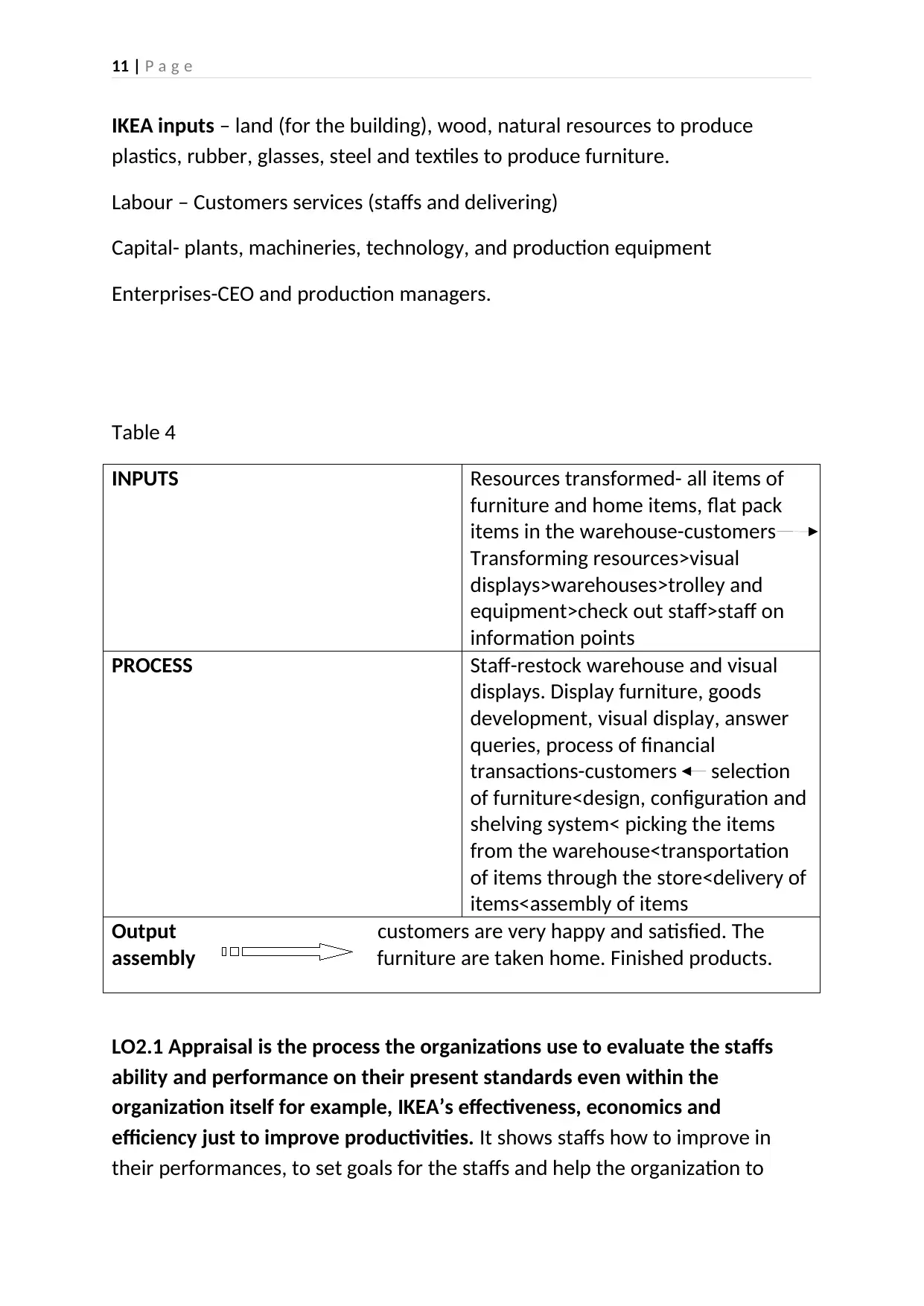
11 | P a g e
IKEA inputs – land (for the building), wood, natural resources to produce
plastics, rubber, glasses, steel and textiles to produce furniture.
Labour – Customers services (staffs and delivering)
Capital- plants, machineries, technology, and production equipment
Enterprises-CEO and production managers.
Table 4
INPUTS Resources transformed- all items of
furniture and home items, flat pack
items in the warehouse-customers
Transforming resources>visual
displays>warehouses>trolley and
equipment>check out staff>staff on
information points
PROCESS Staff-restock warehouse and visual
displays. Display furniture, goods
development, visual display, answer
queries, process of financial
transactions-customers selection
of furniture<design, configuration and
shelving system< picking the items
from the warehouse<transportation
of items through the store<delivery of
items<assembly of items
Output customers are very happy and satisfied. The
assembly furniture are taken home. Finished products.
LO2.1 Appraisal is the process the organizations use to evaluate the staffs
ability and performance on their present standards even within the
organization itself for example, IKEA’s effectiveness, economics and
efficiency just to improve productivities. It shows staffs how to improve in
their performances, to set goals for the staffs and help the organization to
IKEA inputs – land (for the building), wood, natural resources to produce
plastics, rubber, glasses, steel and textiles to produce furniture.
Labour – Customers services (staffs and delivering)
Capital- plants, machineries, technology, and production equipment
Enterprises-CEO and production managers.
Table 4
INPUTS Resources transformed- all items of
furniture and home items, flat pack
items in the warehouse-customers
Transforming resources>visual
displays>warehouses>trolley and
equipment>check out staff>staff on
information points
PROCESS Staff-restock warehouse and visual
displays. Display furniture, goods
development, visual display, answer
queries, process of financial
transactions-customers selection
of furniture<design, configuration and
shelving system< picking the items
from the warehouse<transportation
of items through the store<delivery of
items<assembly of items
Output customers are very happy and satisfied. The
assembly furniture are taken home. Finished products.
LO2.1 Appraisal is the process the organizations use to evaluate the staffs
ability and performance on their present standards even within the
organization itself for example, IKEA’s effectiveness, economics and
efficiency just to improve productivities. It shows staffs how to improve in
their performances, to set goals for the staffs and help the organization to
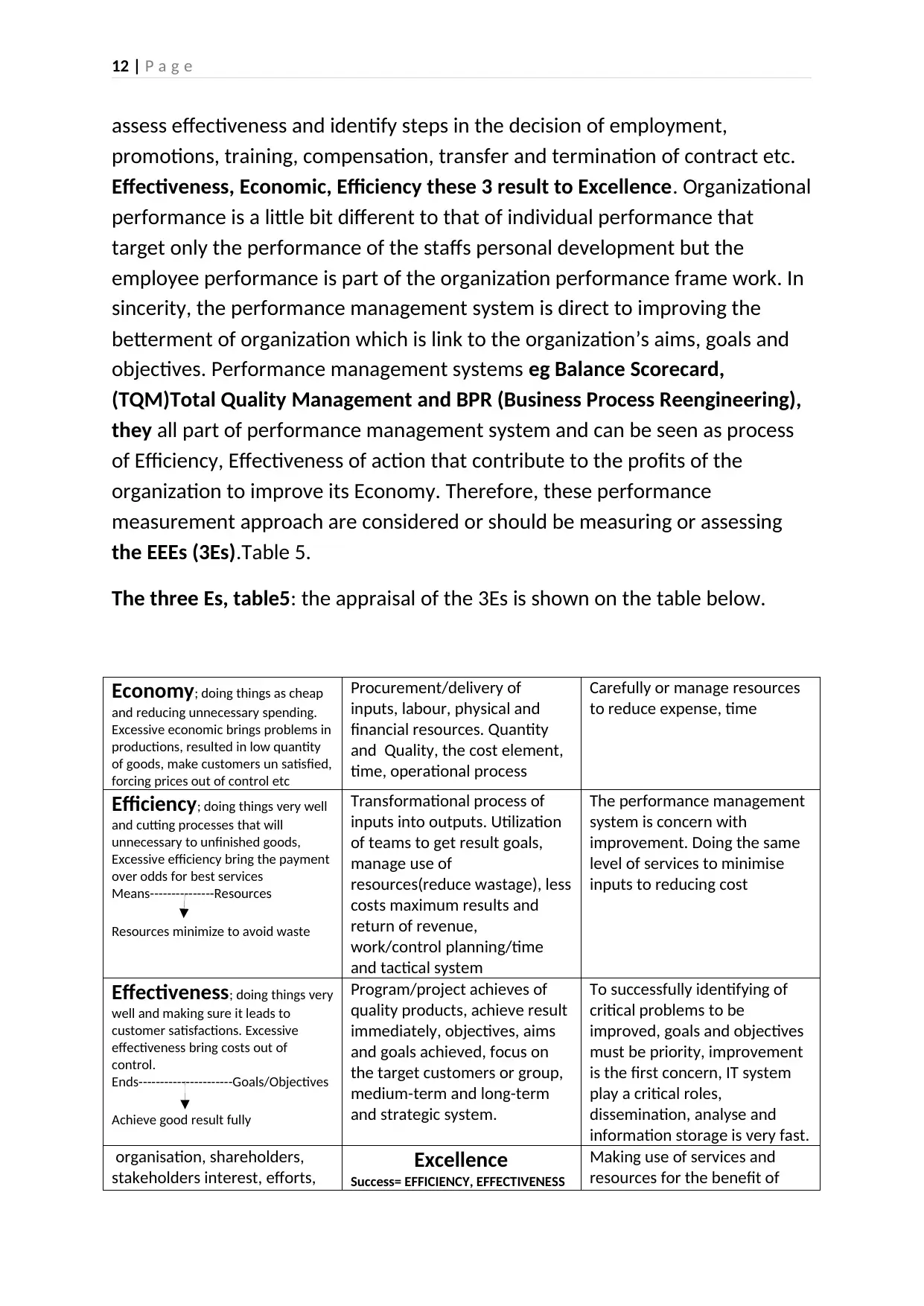
12 | P a g e
assess effectiveness and identify steps in the decision of employment,
promotions, training, compensation, transfer and termination of contract etc.
Effectiveness, Economic, Efficiency these 3 result to Excellence. Organizational
performance is a little bit different to that of individual performance that
target only the performance of the staffs personal development but the
employee performance is part of the organization performance frame work. In
sincerity, the performance management system is direct to improving the
betterment of organization which is link to the organization’s aims, goals and
objectives. Performance management systems eg Balance Scorecard,
(TQM)Total Quality Management and BPR (Business Process Reengineering),
they all part of performance management system and can be seen as process
of Efficiency, Effectiveness of action that contribute to the profits of the
organization to improve its Economy. Therefore, these performance
measurement approach are considered or should be measuring or assessing
the EEEs (3Es).Table 5.
The three Es, table5: the appraisal of the 3Es is shown on the table below.
Economy; doing things as cheap
and reducing unnecessary spending.
Excessive economic brings problems in
productions, resulted in low quantity
of goods, make customers un satisfied,
forcing prices out of control etc
Procurement/delivery of
inputs, labour, physical and
financial resources. Quantity
and Quality, the cost element,
time, operational process
Carefully or manage resources
to reduce expense, time
Efficiency; doing things very well
and cutting processes that will
unnecessary to unfinished goods,
Excessive efficiency bring the payment
over odds for best services
Means---------------Resources
Resources minimize to avoid waste
Transformational process of
inputs into outputs. Utilization
of teams to get result goals,
manage use of
resources(reduce wastage), less
costs maximum results and
return of revenue,
work/control planning/time
and tactical system
The performance management
system is concern with
improvement. Doing the same
level of services to minimise
inputs to reducing cost
Effectiveness; doing things very
well and making sure it leads to
customer satisfactions. Excessive
effectiveness bring costs out of
control.
Ends----------------------Goals/Objectives
Achieve good result fully
Program/project achieves of
quality products, achieve result
immediately, objectives, aims
and goals achieved, focus on
the target customers or group,
medium-term and long-term
and strategic system.
To successfully identifying of
critical problems to be
improved, goals and objectives
must be priority, improvement
is the first concern, IT system
play a critical roles,
dissemination, analyse and
information storage is very fast.
organisation, shareholders,
stakeholders interest, efforts, Excellence
Success= EFFICIENCY, EFFECTIVENESS
Making use of services and
resources for the benefit of
assess effectiveness and identify steps in the decision of employment,
promotions, training, compensation, transfer and termination of contract etc.
Effectiveness, Economic, Efficiency these 3 result to Excellence. Organizational
performance is a little bit different to that of individual performance that
target only the performance of the staffs personal development but the
employee performance is part of the organization performance frame work. In
sincerity, the performance management system is direct to improving the
betterment of organization which is link to the organization’s aims, goals and
objectives. Performance management systems eg Balance Scorecard,
(TQM)Total Quality Management and BPR (Business Process Reengineering),
they all part of performance management system and can be seen as process
of Efficiency, Effectiveness of action that contribute to the profits of the
organization to improve its Economy. Therefore, these performance
measurement approach are considered or should be measuring or assessing
the EEEs (3Es).Table 5.
The three Es, table5: the appraisal of the 3Es is shown on the table below.
Economy; doing things as cheap
and reducing unnecessary spending.
Excessive economic brings problems in
productions, resulted in low quantity
of goods, make customers un satisfied,
forcing prices out of control etc
Procurement/delivery of
inputs, labour, physical and
financial resources. Quantity
and Quality, the cost element,
time, operational process
Carefully or manage resources
to reduce expense, time
Efficiency; doing things very well
and cutting processes that will
unnecessary to unfinished goods,
Excessive efficiency bring the payment
over odds for best services
Means---------------Resources
Resources minimize to avoid waste
Transformational process of
inputs into outputs. Utilization
of teams to get result goals,
manage use of
resources(reduce wastage), less
costs maximum results and
return of revenue,
work/control planning/time
and tactical system
The performance management
system is concern with
improvement. Doing the same
level of services to minimise
inputs to reducing cost
Effectiveness; doing things very
well and making sure it leads to
customer satisfactions. Excessive
effectiveness bring costs out of
control.
Ends----------------------Goals/Objectives
Achieve good result fully
Program/project achieves of
quality products, achieve result
immediately, objectives, aims
and goals achieved, focus on
the target customers or group,
medium-term and long-term
and strategic system.
To successfully identifying of
critical problems to be
improved, goals and objectives
must be priority, improvement
is the first concern, IT system
play a critical roles,
dissemination, analyse and
information storage is very fast.
organisation, shareholders,
stakeholders interest, efforts, Excellence
Success= EFFICIENCY, EFFECTIVENESS
Making use of services and
resources for the benefit of
⊘ This is a preview!⊘
Do you want full access?
Subscribe today to unlock all pages.

Trusted by 1+ million students worldwide
1 out of 41
Related Documents
Your All-in-One AI-Powered Toolkit for Academic Success.
+13062052269
info@desklib.com
Available 24*7 on WhatsApp / Email
![[object Object]](/_next/static/media/star-bottom.7253800d.svg)
Unlock your academic potential
Copyright © 2020–2025 A2Z Services. All Rights Reserved. Developed and managed by ZUCOL.





